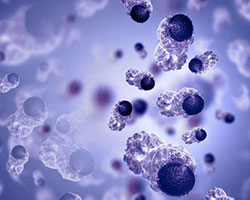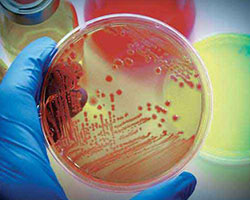
| Therapeutic Area(s) | Oncology | Metabolic | Infectious | Ophthalmology | Neurology | Others |
Cyclin-dependent kinases (CDKs) can be identified as protein kinases that require a separate cyclin subunit, which provides domains for enzymatic activity. CDKs play a major role in modulating transcription and controlling cell division.

| Therapeutic Area(s) | Oncology | Metabolic | Respiratory | Ophthalmology | Others |
Bromodomain and extraterminal domain (BET) proteins are identified as epigenetic readers and can be characterized by the presence of two tandem bromodomains (BD1 and BD2), extraterminal domain (ET), and a C-terminal domain (CTD).

| Therapeutic Area(s) | Others |
Phosphatidylinositol 3-kinase (PI3K) belongs to lipid kinases that has an important role in cell signaling. It acts as a mediator molecule in mTOR/AKT/PI3K signaling cascade.

| Therapeutic Area(s) | NeurologyOthers |
β-site Aβ cleaving enzyme, also known as beta-secretase (BACE), is a precursor of BACE α-amyloid (Aβ) protein generation. It is an aspartic-acid protease, which is an essential component in the formation of myelin sheaths in peripheral nerve cells.

| Therapeutic Area(s) | OncologyOthers |
Mechanistic target of rapamycin (mTOR) is a threonine and serine protein kinase that is a great target for immunosuppressive drug rapamycin. There are two distinct complexes of mTOR: mTOR complex 1 (mTORC1) and mTOR complex 2 (mTORC2).

| Therapeutic Area(s) | OncologyOthers |
OX40 receptor belongs to tumor necrosis factor (TNF) superfamily, whose interactions play an important role in the development of various autoimmune diseases.

| Therapeutic Area(s) | OncologyOthers |
Proteasomes are minute, tub-shaped structures found in cells and are responsible for the breakdown of misfolded and non-functional proteins inside the cells. It is a multi-subunit enzyme complex that plays a central role in the regulation of proteins responsible for controlling cell-cycle progression and apoptosis, and has therefore, become an important target for anti-cancer therapy.

| Therapeutic Area(s) | Oncology | Immunology | Metabolic | Respiratory | Cardiovascular | Neurology | Others |
NF-κB is identified as a family of highly conserved transcription factors, which are responsible for many cellular functions such as regulation of inflammatory responses, apoptosis, cellular growth, and others.

| Therapeutic Area(s) | Oncology | Immunology | Dermatology | Gastroenterology | Musculoskeletal | Neurology | Others |
IL-6 is transcribed by IL-6 gene that encodes a cytokine, which functions in inflammation and maturation of B cells. The IL-6 protein can induce fever in patients suffering from autoimmune diseases, thereby acting as endogenous pyrogens.

| Therapeutic Area(s) | Oncology | Immunology | Dermatology | Gastroenterology | Others |
JAK consists of four intracellular non-receptor tyrosine kinases that help in cytokine mediated signaling through the JAK-STAT pathway. It contains two almost identical phosphate transferring domains in which one domain shows kinase activity and the other regulates the activity of the first via negative inhibition.

| Therapeutic Area(s) | Oncology | Immunology | Metabolic | Respiratory | Infectious | Ophthalmology | Gastroenterology | Nephrology | Neurology | Urology | Others |
Mitochondria (singular: mitochondrion) are cytoplasmic organelles found in eukaryotic cells, such as plants, animals, fungi, and protists. The number of mitochondria present in a eukaryotic cell depend on the metabolic requirements of that cell; and ranges from a single large mitochondrion to thousands of the organelles.

| Therapeutic Area(s) | Oncology | Immunology | Metabolic | Respiratory | Cardiovascular | Musculoskeletal | Urology | Others |
Wnt or β-Catenin signaling pathway plays a key role in the development of pluripotent cells and embryonic development. The pathway regulates cell-to-cell interaction, activates blastocyst, accelerates trophoblast development, accelerate chorion-allantois fusion and implantation.

| Therapeutic Area(s) | Oncology | Immunology | Metabolic | Respiratory | Dermatology | Infectious | Cardiovascular | Hematology | Neurology | Others |
Galectins belong to the family of animal lectins and perform function by interacting with cytoplasmic and nuclear proteins, cell-surface and extracellular matrix glycoproteins and glycolipids to modulate signalling pathways.

| Therapeutic Area(s) | Oncology | Immunology | Metabolic | Respiratory | Dermatology | Infectious | Cardiovascular | Hematology | Ophthalmology | Gastroenterology | Musculoskeletal | Nephrology | Neurology | Urology | Others |
Epidermal growth factor receptors (EGFR) are a group of receptor tyrosine kinase (RTK) that plays a major role in cell proliferation, survival and differentiation. In most of the cancer, EGFR are amplified and overexpressed, due to dysregulation, resulting in cancer development.

| Therapeutic Area(s) | Oncology | Immunology | Respiratory | Cardiovascular | Hematology | Ophthalmology | Gastroenterology | Nephrology | Others |
Endothelin antagonists are drug candidates that acts against endothelin receptors and generate pharmacological actions such as blocking the vasoconstriction and mediate vasodilatation. Endothelin-1 is a peptide which is comprised of 21 amino acids and formed by vascular endothelium.

| Therapeutic Area(s) | Oncology | Metabolic | Respiratory | Dermatology | Infectious | Hematology | Gastroenterology | Neurology | Others |
Mitogen-activated protein kinase (MAPK) are ubiquitous regulators of many cellular functions including cell proliferation, cellular growth, inflammatory responses to stress signals and cell differentiation.

| Therapeutic Area(s) | Oncology | Immunology | Infectious | Hematology | Gastroenterology | Neurology | Others |
MDM2 protein are powerful oncogene which is overexpressed in various cancers, including breast cancer and sarcoma. There are many small molecule drug candidates that are being developed as MDM2 protein inhibitors as monotherapy or combination therapy for the treatment of various cancers.

| Therapeutic Area(s) | Oncology | Immunology | Respiratory | Dermatology | Infectious | Cardiovascular | Hematology | Ophthalmology | Gastroenterology | Nephrology | Neurology | Urology | Others |
Interleukin receptors are a group of cytokine receptors that are expressed by leukocytes. Interleukin receptors play an important role in the functioning of the immune system.

| Therapeutic Area(s) | Oncology | Respiratory | Infectious | Cardiovascular | Ophthalmology | Gastroenterology | Neurology | Urology | Others |
Interleukin 8 is a chemokine produced by various immune cells. They promote angiogenesis, proliferation and development of cancerous cells. The other diseases which are associated with interleukin 8 are depression, schizophrenia, bipolar disorder, migraine, Alzheimer’s disease, colitis, rheumatoid arthritis, multiple sclerosis, asthma, allergic rhinitis, psoriasis, eczema and others.

| Therapeutic Area(s) | Infectious | Others |
Human immunodeficiency virus (HIV) fusion inhibitors is the new class of antiretroviral drugs for the treatment of HIV infections. Failure of combination antiretroviral therapy in patients with HIV, has increased the risk of disease progression.

| Therapeutic Area(s) | Oncology | Immunology | Metabolic | Respiratory | Dermatology | Infectious | Nephrology | Neurology | Others |
Hepatocyte growth factor (HGF) is secreted by human pancreatic stellate cells and present predominantly on cancer cells. Thus, HGF inhibitors has emerged as an effective therapy in preventing local tumor growth.

| Therapeutic Area(s) | Oncology | Immunology | Infectious | Cardiovascular | Gastroenterology | Neurology | Others |
Glycogen synthase kinase 3 beta (GSK-3β) is an attractive target for the treatment of psychiatric disorders and neurodegenerative diseases. Many GSK-3β inhibitors have been developed for the treatment of different central nervous system disorders.

| Therapeutic Area(s) | Neurology | Others |
Tau protein is found in abundance in neurons of the central nervous system. This protein is a product of microtubule-associated protein tau (MAPT) gene, that is located on chromosome 17. It is associated with pathologies of several nervous system disorders, such as dementia, Parkinson’s disease, and Alzheimer’s disease.

| Therapeutic Area(s) | Oncology | Immunology | Respiratory | Dermatology | Infectious | Hematology | Ophthalmology | Others |
Spleen tyrosine kinase (Syk) is a protein that belongs to the family of tyrosine kinases with an ability to initiate the inflammatory responses, by connecting immune cell receptors to intracellular signaling pathways.

| Therapeutic Area(s) | Oncology | Immunology | Metabolic | Respiratory | Dermatology | Infectious | Cardiovascular | Hematology | Ophthalmology | Nephrology | Neurology | Urology | Others |
RNA interference (RNAi) is a molecule type that silences the gene and limits the transcription of the mutated gene. Gene silencing is a novel mechanism that inactivates the transcripts of mutated gene, by activating sequence specific RNA degradation process.

| Therapeutic Area(s) | Oncology | Metabolic | Respiratory | Cardiovascular | Ophthalmology | Nephrology | Neurology | Urology | Others |
Rho kinase inhibitor, also known as ROCK inhibitor, inhibits the rho kinases, a family of small GTP-binding protein. Rho kinases are found to regulate cell motility, proliferation, shape, gene expression, apoptosis, and are also involved in the signalling pathway.

| Therapeutic Area(s) | Oncology | Immunology | Metabolic | Respiratory | Dermatology | Infectious | Ophthalmology | Gastroenterology | Others |
p53 is the tumor suppressor transcription factor that activates to various stimulus, including uncontrolled cell proliferation, oncogene over-expression, and DNA damage. p53 antigen modulators helps in preventing cancer development through regulation of cell cycle and apoptosis.

| Therapeutic Area(s) | Immunology | Respiratory | Cardiovascular | Ophthalmology | Gastroenterology | Neurology | Others |
Nav1.7 voltage-gated sodium channel inhibitors are the drug candidates that target the sodium channels Nav1.7 and have been significant in pain management. The sodium channels Nav1.7 receptors are generally found in two types of neurons: nociceptive pain neurons, such as trigeminal neurons and dorsal root ganglion; and sympathetic ganglion neurons which form a part of the autonomic (involuntary) nervous system. These receptors play an important role in generation and conduction of action potential.

| Therapeutic Area(s) | Oncology | Immunology | Dermatology | Others |
Cytotoxic T-lymphocyte antigen-4 (CTLA-4) plays important role in the T-cell regulation at an early stage of naive T-cell activation, primarily in the lymph nodes. CTLA-4 has emerged as an attractive cancer immunotherapy as a part of “immune checkpoint blockade”.

| Therapeutic Area(s) | Oncology | Metabolic | Respiratory | Infectious | Hematology | Gastroenterology | Nephrology | Neurology | Others |
Cyclophilin befits in the group of protein that shows peptidyl-prolyl cis-trans isomerase activity, found in all types of cells. In humans, 16 cyclophilins have been identified till date. Cyclophilin A, a member of cyclophilin group, mediate the action of immunosuppressive drugs.

| Therapeutic Area(s) | Oncology | Immunology | Metabolic | Respiratory | Dermatology | Infectious | Cardiovascular | Hematology | Ophthalmology | Gastroenterology | Musculoskeletal | Nephrology | Neurology | Urology | Others |
Cell cycle inhibitors include cyclin inhibitors and cyclin-dependent kinases (CDKs), which plays major role in developing new class of anti-cancer therapies. Also, cell cycle inhibitors in combination with chemotherapy, overcome drug resistance and improve cytotoxic efficacy. CDKs are rational targets for cancer treatment, that could restore cell-cycle checkpoints and may induce apoptosis.

| Therapeutic Area(s) | Oncology | Immunology | Infectious | Musculoskeletal | Others |
Cathepsin K is a protease enzyme which is coded by CTSK gene. The function associated with the gene involves bone remodelling and resorption. Cathepsin K is a member of peptidase C1 protein family and expressed mainly in osteoclasts.

| Therapeutic Area(s) | Oncology | Immunology | Metabolic | Dermatology | Hematology | Ophthalmology | Gastroenterology | Neurology | Urology | Others |
Aurora kinase are proteins that function as mitotic regulators and are aberrantly expressed in cancerous cells. Aurora kinase inhibitors target these aberrantly expressed regulators, provides genetic stability and prevents tumorigenesis.

| Therapeutic Area(s) | Oncology | Immunology | Metabolic | Respiratory | Dermatology | Cardiovascular | Hematology | Ophthalmology | Musculoskeletal | Nephrology | Others |
Angiopoietin (ANG) receptor plays a crucial role in regulation of vascular permeability and pathological vascular remodelling during tumour angiogenesis, metastasis and inflammation. Thus, it has emerged as a new clinical approach for the development of therapeutics which treat cancer and ophthalmological diseases.

| Therapeutic Area(s) | Oncology | Immunology | Metabolic | Infectious | Hematology | Gastroenterology | Nephrology | Neurology | Others |
Adenosine 5-monophosphate activated protein kinase (AMPK) plays an important role in regulation of homeostasis. Dysregulation of AMPK can result in many diseases which includes obesity and type 2 diabetes. Several studies have also suggested that AMPK are also associated with the development of neurological diseases and cancer.

| Therapeutic Area(s) | Oncology | Respiratory | Dermatology | Infectious | Cardiovascular | Hematology | Ophthalmology | Gastroenterology | Musculoskeletal | Neurology | Urology | Others |
Androgens are responsible for the development of male characteristics by binding to androgen receptors. Androgen receptor plays an important role in the development and progression of prostate cancer. Thus, it has been an attractive target for the clinical interventions and treatment of prostate cancer.

| Therapeutic Area(s) | Oncology | Respiratory | Dermatology | Infectious | Cardiovascular | Hematology | Gastroenterology | Nephrology | Neurology | Others |
Alpha-synuclein is a protein that is abundantly found in the brain. The minimal amount of alpha-synuclein is also found in the heart and other tissues. The protein is prominently found at the tips of the nerve cells. It helps in the maintaining supply of the synaptic vesicle in presynaptic terminals. In addition, the alpha-synuclein protein also helps in release of dopamine.

| Therapeutic Area(s) | Oncology | Metabolic | Cardiovascular | Ophthalmology | Nephrology | Neurology | Urology | Others |
Akt, also known as PKB, is generally activated in several types of cancers such as breast, gastric, lung, ovary, and pancreatic cancer. Akt inhibitor prevent the functioning of activated form of Akt kinases. Akt kinases are also involved in promoting growth factor-mediated cells that mediates cell proliferation and inhibition of apoptosis through the inactivation of pro-apoptotic proteins, such as mouse double minute 2 homolog (MDM2) and Bcl-2 antagonist of cell death.